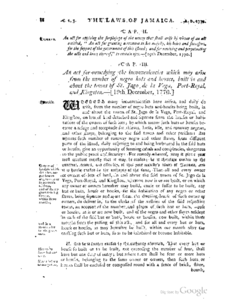Full Transcript
WHEREAS many inconveniencies have arisen, and daily do arise, from the number of negro huts and houses being built, in and about the towns of St. Jago de la Vega, Port-Royal, and Kingston, on lots of land detached and separate from the houses or habitations of the owners of such lots; by which means such huts or houses become a refuge and receptacle for thieves, loose, idle, and runaway negroes, and other slaves, belonging to the said towns and other parishes: And whereas such number of runaway negro and other slaves, from different parts of the island, daily resorting to and being harboured in the said huts or houses, give an opportunity of forming cabals and conspiracies, dangerous to the public peace and security: For remedy whereof, May it please your most excellent majesty that it may be enacted; be it therefore enacted by the governor, council, and assembly, of this your majesty’s island of Jamaica, and it is hereby enacted by the authority of the same, That all and every owner or owners of lots of land, in and about the said towns of St. Jago de la Vega, Port-Royal, and Kingston, whereon now is or are built, or on which any owner or owners hereafter may build, cause or suffer to be built, any hut or huts, house or houses, for the habitation of any negro or other slaves, being separate and apart from the dwelling-house of such owner or owners, do deliver in, to the clerks of the vestries of the said respective towns, an account of the number and places of such hut or huts, house or houses, as is or are now built, and of the negro and other slaves resident in each of the said hut or huts, house or houses, now built, within three months from the passing of this act; and for all and every hut or huts, house or houses, as may hereafter be built, within one month after the erecting such hut or huts, so as to be inhabited or become habitable.
II. And be it further enacted by the authority aforesaid, That every hut or house so built or to be built, not exceeding the number of four, shall have but one door of entry; but where there shall be four or more huts or houses, belonging to the same owner or owners, then such huts or houses shall be enclosed or compassed round with a fence of brick, stone, boards or palisadoes, of the height of seven feet at the least, which shall be kept in good and sufficient repair (and that all other fences shall be destroyed); each of which enclosures shall have but one door of entry.
III. And be it further enacted by the authority aforesaid, That in case any owner or owners of such hut or huts, house or houses, which are built, or hereafter may be built, shall neglect or refuse to deliver in such account, or shall neglect so to enclose such huts or houses as before directed, to suffer or permit any negro or other slave to dwell therein, except such as belong to, or are employed by, the proprietors of the said hut or huts, house or houses, then it shall and may be lawful to and for the justices and vestry of the said respective towns, by order in writing under their hands and seals, to cause such hut or huts, house or houses, to be pulled down; which order shall be entered of record in the vestry-book.
IV. And be it further enacted by the authority aforesaid, That the secretary of this island do cause a copy of this act to be fixed up in the most public place of each of the said three towns, and that he also send a copy thereof to the justices and vestry of each of the said towns, within fifteen days after the passing of this act.
Date
Location
Citation
"An act for remedying the inconveniencies which may arise from the number of negro huts and houses, built in and about the towns of St. Jago de la Vega, Port-Royal, and Kingston." Laws of Enslavement and Freedom in the Anglo-Atlantic World, accessed Nov 21, 2024, https://slaveryandfreedomlaws.lib.unb.ca/laws/294
Copy
Download Original
Images published from the Google Books Library are digitized by Google as a part of an ongoing effort to preserve the information in books and make it universally accessible. Images used in this project have been determined to be in the public domain through the Google Books Library Project. Further bibliographic information, including the location of the original document is available from the Google Book Library website.
